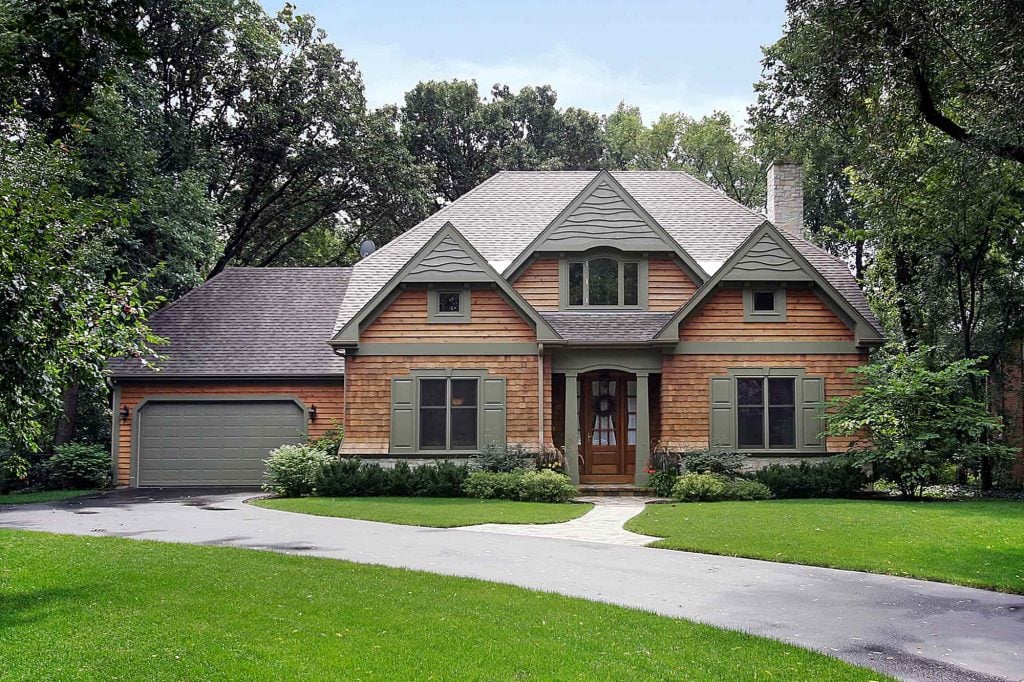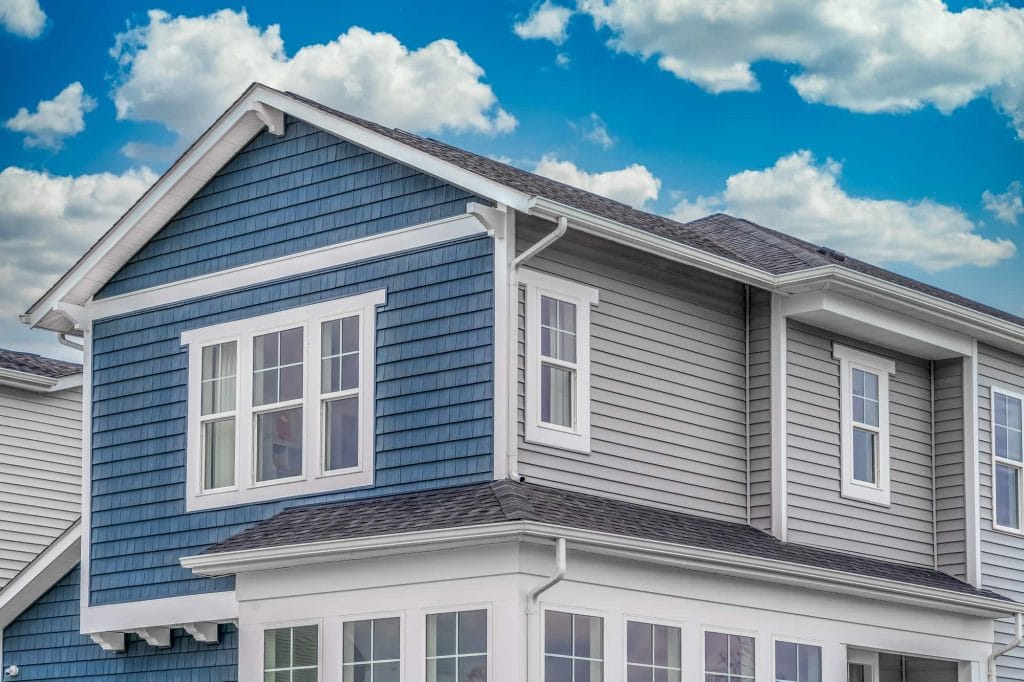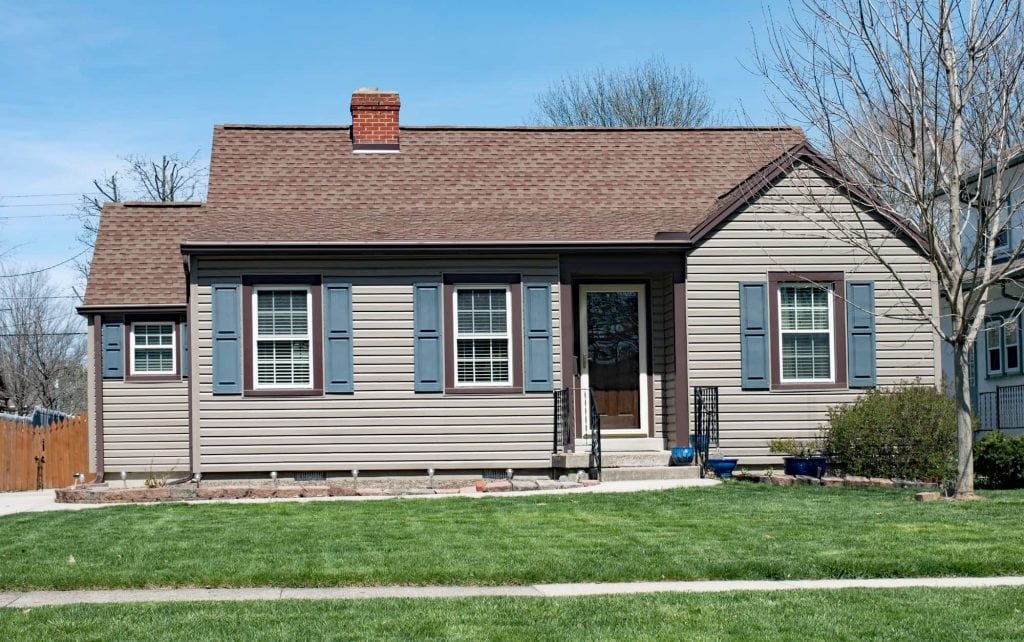Selecting the appropriate house siding is a critical part of any home project, whether building a new property or refurbishing an existing one. The right choice can enhance your home’s curb appeal, boost its value, and provide adequate protection against weather conditions.
All popular siding options have advantages and disadvantages depending on cost, durability, maintenance, and a wide variety of aesthetics. Read on to learn more about the common types of house siding and how they can transform your home’s appearance and performance.
Vinyl Siding
Vinyl siding is one of the most popular types of house siding in America, boasting various colors and styles to match any architectural design. It’s crafted from durable synthetic polyvinyl chloride, ensuring your home remains beautiful and sturdy for years.

Pros of Vinyl Siding
- Minimal Maintenance: Vinyl siding requires little ongoing maintenance. An occasional wash with soapy water will keep it looking fresh and new. This low-maintenance siding material is an excellent choice for those who want a clean, crisp appearance with minimal fuss.
- Wide Range of Colors and Styles: You’re spoiled for choice with the variety of colors and classic style choices with vinyl siding. The siding style diversity is immense, from traditional lap siding to vertical panels and beaded designs. It comes in a broad palette of color choices, enabling homeowners to create an exterior home design that reflects their style.
- Affordable and Cost-Effective: When considering material costs and installation expenses, vinyl siding is a highly affordable option. Its durability and long lifespan also make it a cost-effective choice in the long run.
Cons of Vinyl Siding
- Vulnerable to Extreme Temperatures and Fading: While vinyl siding can withstand various weather conditions, it’s not invincible. Extreme temperatures can cause the siding to warp or buckle. However, modern manufacturing techniques have improved vinyl’s weather resistance significantly. Furthermore, while fading may occur over time, many vinyl siding products now come with UV-resistant coatings that slow down the process.
- Limited Lifespan Compared to Other Options: While vinyl siding has a reasonable lifespan, it only measures up to other siding materials like brick or fiber cement. However, with proper maintenance and care, you can extend the life of your vinyl siding considerably.
- Susceptible to Cracks and Damage from Impact: Vinyl can get damaged due to severe hail or other debris impacts. However, its affordability makes replacement or repair a more manageable task. Moreover, many manufacturers offer impact-resistant vinyl siding products to help homeowners in areas prone to harsh weather conditions.
In conclusion, vinyl siding is popular for homeowners seeking a versatile, low-maintenance, cost-effective siding option. It may not be the most durable type of siding available, but its benefits outweigh its drawbacks for many. Remember to consult with a professional siding contractor for proper installation and maintenance.
Wood Siding
Different types of wood siding have been a favorite choice among homeowners for centuries, owing to its classic charm and natural warmth. Whether in solid real wood, wood shingles, or log home design, this house siding enhances a property’s aesthetic appeal and adds a touch of rustic elegance.

Pros of Wood Siding
- Natural and Timeless Aesthetic Appeal: Natural materials such as real wood siding offers a wide range of unique and timeless aesthetics that no synthetic material can truly replicate. Available in various styles, such as clapboard siding, cedar shingles, and vertical or horizontal panels, it brings a natural beauty that can complement any architectural style.
- Eco-friendly and Renewable Material: Wood is an eco-friendly and renewable resource, making it an excellent option for the environmentally conscious homeowner. When properly managed, wood siding can be a sustainable choice that contributes to preserving our natural environment.
- Easily Repaired and Modified: Unlike other siding materials, wood siding can be easily repaired or modified, saving you money in the long run. Wood siding offers excellent flexibility, whether a simple patch job or a significant modification.
Cons of Wood Siding
- High Maintenance and Regular Painting/Staining: Wood siding requires regular maintenance, including frequent painting or staining, to maintain its look and durability. However, this also allows homeowners to change the color or finish of their home’s exterior, giving it a fresh, new appearance.
- Prone to Rot, Pests, and Warping: Wood siding can be susceptible to rot, insect infestations, and warping. Thankfully, these problems can be mitigated through proper installation, maintenance, and the use of specially treated wood that is more resistant to these challenges.
- More Expensive Compared to Other Siding Options: While wood siding may have a higher initial cost than other siding materials, its timeless appeal and potential to increase your home’s resale value make it a worthy investment.
Fiber Cement Siding
Fiber cement siding is a popular option that marries the strength and durability of cement with the versatility and ease of handling associated with a traditional variety of materials. This siding material is a robust and aesthetically versatile choice for any home, composed of a mixture of cement, cellulose fibers, and sand.

Pros of Fiber Cement Siding
- Durable and Resistant to Fire, Insects, and Rot: Fiber cement siding is highly durable and resistant to many common issues plaguing other siding materials, such as fire, insect damage, and rot. This high durability makes it an excellent choice for homes in areas with harsh weather conditions.
- Low Maintenance and Long Lifespan: Fiber cement siding requires minimal maintenance, unlike real wood siding. It doesn’t need to be painted as frequently and resists warping and buckling. Furthermore, its long lifespan makes it a cost-effective option over time.
- Wide Range of Styles and Textures Available: Fiber cement siding comes in a wide range of styles and textures, mimicking the look of wood, brick, or stone. This variety allows homeowners to achieve their desired aesthetic without sacrificing durability or maintenance requirements.
Cons of Fiber Cement Siding
Relatively Higher Installation Cost: The initial cost of fiber cement siding, including installation, can be higher than other siding options. However, the long-term savings in maintenance costs and the potential increase in your home’s value can offset the upfront investment.
- Requires Professional Installation: Installing fiber cement siding can be a complex task requiring professional expertise. While this means an additional initial cost, a professional installation ensures the longevity and optimal performance of your siding.
- Cutting and Handling the Material Can Release Harmful Dust Particles: When cut, fiber cement siding can release silica dust, which can be harmful if inhaled. Therefore, proper safety measures should be observed during installation. When handled by professionals with appropriate safety equipment, the risk is mitigated, making it a safe option for your home.
Aluminum Siding
Aluminum siding is popular for homeowners due to its resilience and practicality. Being a metal siding, it provides a sleek, modern aesthetic and stands up well against various weather conditions, making it a worthy contender in exterior siding options.

Pros of Aluminum Siding
- Lightweight and Easy to Install: Aluminum is lightweight, making it easier to handle and install than other siding types. This factor can lead to reduced labor costs and a quicker installation process.
- Resistant to Fire, Insects, and Rot: As a metal siding, aluminum siding is notably resistant to many issues plaguing other siding materials. Its metal nature makes it immune to fire damage, insect infestation, and rot, contributing to its longevity and durability.
- Can be Painted and Customized: One of the significant advantages of aluminum siding is its adaptability. It can be painted in various colors to suit your home’s aesthetic. This factor allows homeowners to regularly update their exterior appearance without a complete siding replacement.
Cons of Aluminum Siding
- Prone to Dents and Scratches: Aluminum siding can be susceptible to dents and scratches due to the material’s relative softness. However, minor weather damage can often be fixed without replacing entire panels, and in many cases, the siding’s textured surface can help hide minor imperfections.
- Fading and Chalking May Occur Over Time: Over time, aluminum siding may exhibit signs of fading and chalking due to weather exposure. However, a fresh coat of paint can restore its original luster, keeping your home looking its best.
- Limited Color Options Compared to Other Siding Types: While aluminum siding can be painted, it may not offer as extensive a color range as vinyl or fiber cement siding. Nevertheless, the ability to repaint aluminum siding means you can refresh or change your home’s color.
Brick Siding
Brick siding is an esteemed and traditional type of house siding renowned for its durability, elegance, and energy efficiency. The classic beauty of brick has proven timeless, appealing to a broad array of architectural styles and personal preferences.

Pros of Brick Siding
- Exceptionally Durable and Long-Lasting: Brick is one of the most durable types of siding, capable of lasting over a century with proper maintenance. Despite the initial investment, this long-lasting nature makes it a cost-effective choice.
- Provides Excellent Insulation and Energy Efficiency: Brick siding acts as a natural insulator, keeping your home cool in the summer and warm in the winter. This factor can significantly reduce energy costs and increase the overall comfort of your home.
- Low Maintenance and Resistant to Fire, Rot, and Pests: Brick requires minimal maintenance compared to other siding types, saving homeowners time and money in the long run. It’s resistant to fire, rot, and pests, making it an exceptionally safe and worry-free choice for your home’s exterior.
Cons of Brick Siding
- Expensive Upfront Cost: While brick siding may have a higher initial cost than other materials, it’s essential to consider its longevity and durability. The price per year becomes significantly less when spread over the lifespan of the siding, and the added home value can offset the upfront expense.
- Requires Professional Installation and Expertise: Brick siding requires professional installation due to its weight and the skill to lay the bricks properly. However, this ensures a quality installation that will stand the test of time, and many homeowners find the cost worth the lasting result.
- Limited Design Options and Difficult to Modify or Repair: While brick may offer fewer design options than other siding types, its classic and timeless appeal is versatile and can complement various architectural styles. And while it can be challenging to modify or repair, the durability of brick siding often makes this a rare necessity.
Stucco Siding
Stucco siding is a durable, energy-efficient, and visually appealing type of house siding. As a plaster made from cement, sand, lime, and water, it has been a popular choice for exterior home design in regions with a dry climate like the southwest.

Pros of Stucco Siding
- Versatile and Can Create a Unique, Textured Look: Stucco can be applied in various textures, allowing homeowners to customize their homes’ exterior appearance. Stucco offers many stylistic options, from a rough, hand-troweled finish to a smooth, Spanish-inspired look.
- Durable and Can Withstand Various Weather Conditions: Stucco is resistant to hot and cold weather extremes, making it an excellent choice for homeowners in various climates. It can also withstand rain, hail, and even minor physical impacts.
- Excellent Insulation Properties: Stucco siding provides excellent insulation, keeping homes more relaxed in the summer and warmer in the winter. This factor can lead to significant energy savings over the lifetime of the house.
Cons of Stucco Siding
- Requires Professional Installation and Expertise: While stucco installation does require professional expertise, this ensures a durable, attractive, and long-lasting exterior finish. The outcome justifies the need for a professional touch.
- Prone to Cracking and Damage from Impact: While stucco can resist minor impacts, it may crack when subjected to more enormous effects or significant structural shifts. However, these cracks can often be repaired with total replacement.
- Regular Maintenance and Occasional Re-painting Necessary: Although stucco requires some maintenance, it’s relatively low compared to other siding materials. An occasional wash and fresh coat of paint will keep your stucco siding looking new for years.
Moisture Management For Different House Sidings
Moisture management is crucial for various house siding materials, including vinyl, wood, fiber cement, aluminum, brick, and stucco. Proper installation, maintenance, and regular inspections are essential.
Vinyl needs tight seals and crack prevention. Wood requires sealing, inspection, and repainting. Fiber cement demands proper flashing and caulking. Aluminum needs sealing and gap checks. Brick requires weep holes and mortar inspection. Stucco needs a moisture barrier and repairs for cracks and caulking to prevent moisture-related issues.
Key Takeaways
When selecting house siding, it’s crucial to consider the different types available – vinyl, wood, fiber cement, aluminum, brick, and stucco. Each has unique pros and cons that can impact your home’s aesthetic appeal, durability, and maintenance. When deciding, consider your personal preferences, budget, and the specific requirements of your geographical location.
While some materials may require more upfront investment, they offer long-term benefits such as low maintenance costs or added home value. Always consult with professional siding contractors before ensuring you’re choosing the right siding for your specific needs.
Ready to find your perfect home equipped with your preferred siding? Start your home search in your desired area at eXp Realty, and sign up for daily or weekly alerts for new listings tailored to your preferences. For additional support, the local eXp real estate agents are here to help.
FAQs: House Siding
Understanding house siding involves asking the right questions. Here are some frequently asked questions to guide you in your selection process.
What is the cheapest way to side a house?
Vinyl siding is the most affordable option, offering low initial cost and minimal maintenance. Variety of styles that include real wood siding can be more expensive.
What is the most expensive siding for a house?
Natural stone and solid brick sidings are typically the most expensive due to the cost of materials and the labor-intensive installation process.
How much is the siding for 1500 sq ft?
The cost of siding for a 1500 sq ft house depends on the type of siding chosen but can range from $5,000 for vinyl siding to over $30,000 for high-end materials like brick or stone.
How much does 1,000 square feet of siding cost?
Again, the cost varies based on the siding material. On average, expect to pay between $3,000 to $20,000.
What is the easiest siding to install?
Vinyl and aluminum siding are considered the easiest to install, often allowing for DIY installation. However, in many cases it is wise to involve a professional.
What type of siding lasts the longest?
Brick, stone, and fiber cement sidings are known for their longevity, often lasting the lifetime of the house with proper maintenance.
What siding can I get on a budget?
Vinyl and aluminum are budget-friendly options that still offer durability and a range of style choices.
Should you remove the old siding before installing a new one?
While not always necessary, removing old siding can allow for inspection and repair of any underlying water damage, leading to a longer-lasting new siding installation.
Can I install vinyl siding myself?
Yes, homeowners can install vinyl siding with the proper tools and guidelines. However, for the best results, consider hiring a professional contractor.
What siding makes a house look bigger?
Light-colored siding can make a house appear more prominent. Additionally, horizontal lap siding can create a widening effect.
Which siding is more energy-efficient?
Insulated vinyl siding and stucco siding are considered the most energy-efficient options.
What siding doesn’t mold?
Fiber cement, brick, and vinyl sidings resist mold and mildew.
How often should the siding be replaced?
The lifespan of siding depends on the material but generally ranges from 20 to 100 years. Regular maintenance can prolong its life.
What is the best waterproof siding?
Vinyl, brick, and fiber cement sidings are known for their water-resistant properties.





